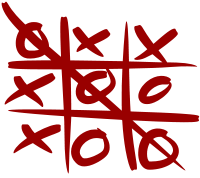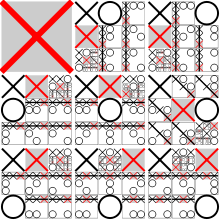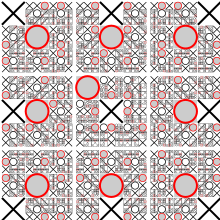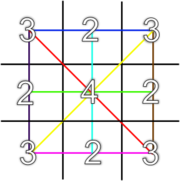Tic-tac-toe

A completed game of Tic-tac-toe
|
| Genre(s) |
Paper-and-pencil game |
| Players |
2 |
| Playing time |
~1 minute |
| Random chance |
None |
| Skill(s) required |
Strategy, tactics, observation |
| Synonym(s) |
Noughts and crosses
Xs and Os |
Tic-tac-toe (also known as Noughts and crosses or Xs and Os) is a paper-and-pencil game for two players, X and O, who take turns marking the spaces in a 3x3 grid. The player who succeeds in placing three of their marks in a horizontal, vertical, or diagonal row wins the game.
The following example game is won by the first player, X:
Players soon discover that best play from both parties leads to a draw. Hence, Tic-tac-toe is most often played by young children.
Because of the simplicity of Tic-tac-toe, it is often used as a pedagogical tool for teaching the concepts of good sportsmanship and the branch of artificial intelligence that deals with the searching of game trees. It is straightforward to write a computer program to play Tic-tac-toe perfectly, to enumerate the 765 essentially different positions (the state space complexity), or the 26,830 possible games up to rotations and reflections (the game tree complexity) on this space.
The game can be generalized to an m,n,k-game in which two players alternate placing stones of their own color on an mxn board, with the goal of getting k of their own color in a row. Tic-tac-toe is the (3,3,3)-game.
History
An early variant of Tic-tac-toe was played in the Roman Empire, around the first century BC. It was called Terni Lapilli and instead of having any number of pieces, each player only had three, thus they had to move them around to empty spaces to keep playing. The game's grid markings have been found chalked all over Rome. However, according to Claudia Zaslavsky's book Tic Tac Toe: And Other Three-In-A Row Games from Ancient Egypt to the Modern Computer, Tic-tac-toe could originate back to ancient Egypt. Another closely related ancient game is Three Men's Morris which is also played on a simple grid and requires three pieces in a row to finish.
The different names of the game are more recent . The first print reference to "Noughts and crosses", the British name, appeared in 1864. In his novel "Can You Forgive Her", 1864, Anthony Trollope refers to a clerk playing "tit-tat-toe". The first print reference to a game called "tick-tack-toe" occurred in 1884, but referred to "a children's game played on a slate, consisting in trying with the eyes shut to bring the pencil down on one of the numbers of a set, the number hit being scored". "Tic-tac-toe" may also derive from "tick-tack", the name of an old version of backgammon first described in 1558. The U.S. renaming of Noughts and crosses as Tic-tac-toe occurred in the 20th century.
In 1952, OXO (or Noughts and Crosses) for the EDSAC computer became one of the first known video games. The computer player could play perfect games of Tic-tac-toe against a human opponent.
In 1975, Tic-tac-toe was also used by MIT students to demonstrate the computational power of Tinkertoy elements. The Tinkertoy computer, made out of (almost) only Tinkertoys, is able to play Tic-tac-toe perfectly. It is currently on display at the Museum of Science, Boston.
Combinatorics

The first two plies of the
game tree for Tic-tac-toe. Once rotations and reflections are eliminated, there are only three opening moves - a corner, a side or the middle.
Despite its apparent simplicity, Tic-tac-toe requires detailed analysis to determine even some elementary combinatory facts, the most interesting of which are the number of possible games and the number of possible positions. A position is merely a state of the board, while a game usually refers to the way a terminal position is obtained.
Naive counting leads to 19,683 possible board layouts (39 since each of the nine spaces can be X, O or blank), and 362,880 (i.e. 9!) possible games (different sequences for placing the Xs and Os on the board). However, two matters much reduce these numbers:
- The game ends when three-in-a-row is obtained.
- The number of Xs is always either equal to or exactly 1 more than the number of Os (if X starts).
The complete analysis is further complicated by the definitions used when setting the conditions, like board symmetries.
Number of terminal positions
When considering only the state of the board, and after taking into account board symmetries (i.e. rotations and reflections), there are only 138 terminal board positions. Assuming that X makes the first move every time:
- 91 distinct positions are won by (X)
- 44 distinct positions are won by (O)
- 3 distinct positions are drawn
Strategy

Optimal strategy for player X. In each grid, the shaded red X denotes the optimal move, and the location of O's next move gives the next subgrid to examine. Note that only two sequences of moves by O (both starting with center, top-right, left-mid) lead to a draw, with the remaining sequences leading to wins from X.

Optimal strategy for player O. Player O can always force a win or draw by taking center. If it is taken by X, then O must take a corner
A player can play a perfect game of Tic-tac-toe (to win or, at least, draw) if they choose the first available move from the following list, each turn, as used in Newell and Simon's 1972 tic-tac-toe program.
- Win: If the player has two in a row, they can place a third to get three in a row.
- Block: If the opponent has two in a row, the player must play the third themselves to block the opponent.
- Fork: Create an opportunity where the player has two threats to win (two non-blocked lines of 2).
- Blocking an opponent's fork:
- Option 1: The player should create two in a row to force the opponent into defending, as long as it doesn't result in them creating a fork. For example, if "X" has a corner, "O" has the center, and "X" has the opposite corner as well, "O" must not play a corner in order to win. (Playing a corner in this scenario creates a fork for "X" to win.)
- Option 2: If there is a configuration where the opponent can fork, the player should block that fork.
- Center: A player marks the center. (If it is the first move of the game, playing on a corner gives "O" more opportunities to make a mistake and may therefore be the better choice; however, it makes no difference between perfect players.)
- Opposite corner: If the opponent is in the corner, the player plays the opposite corner.
- Empty corner: The player plays in a corner square.
- Empty side: The player plays in a middle square on any of the 4 sides.
The first player, who shall be designated "X", has 3 possible positions to mark during the first turn. Superficially, it might seem that there are 9 possible positions, corresponding to the 9 squares in the grid. However, by rotating the board, we will find that in the first turn, every corner mark is strategically equivalent to every other corner mark. The same is true of every edge mark. For strategy purposes, there are therefore only three possible first marks: corner, edge, or center. Player X can win or force a draw from any of these starting marks; however, playing the corner gives the opponent the smallest choice of squares which must be played to avoid losing.
The second player, who shall be designated "O", must respond to X's opening mark in such a way as to avoid the forced win. Player O must always respond to a corner opening with a center mark, and to a center opening with a corner mark. An edge opening must be answered either with a center mark, a corner mark next to the X, or an edge mark opposite the X. Any other responses will allow X to force the win. Once the opening is completed, O's task is to follow the above list of priorities in order to force the draw, or else to gain a win if X makes a weak play.
To guarantee a draw for O, however:
- If X does not play center opening move (playing a corner is the best opening move), take center, and then a side middle. This will stop any forks from happening. If O plays a corner, a perfect X player has already played the corner opposite their first and proceeds to play a 3rd corner, stopping O's 3-in-a-row and making their own fork. However, if X is not a perfect player and has played a corner and then a side middle, O should not play the opposite side middle as the second move, because then X is not forced to block in the next move and can fork.
- If O takes center (best move for them), X should take the corner opposite the original, and proceed as detailed above. The only way for O to force a tie against a perfect X player is if O plays middle and then a side-middle.
- If O plays a corner or side-middle first, X is guaranteed to win:
- If corner, X simply takes any of the other 2 corners, and then the last, a fork.
- If O plays a side-middle, X takes the only corner that O's blocking won't make 2 in a row. O will block, but the best of the other two will be seen by X, and O is forked.
- If X plays center opening move, O should pay attention and not allow a fork. X should play a corner first.

Initiative in start game
Variations
Many board games share the element of trying to be the first to get n-in-a-row, including Three Men's Morris, Nine Men's Morris, pente, gomoku, Qubic, Connect Four, Quarto, Gobblet, Order and Chaos, Toss Across, and Mojo. Tic-tac-toe is an instance of an m,n,k-game, where two players alternate taking turns, as they do in tic-tac-toe, on an mxn board until one of them gets k in a row. Harary's generalized tic-tac-toe is an even broader generalization.
Other variations of tic-tac-toe include:
- 3-dimensional tic-tac-toe on a 3x3x3 board. In this game, the first player has an easy win by playing in the centre if 2 people are playing. Another variant, Qubic, is played on a 4x4x4 board; it was solved by Oren Patashnik in 1980 (the first player can force a win). Higher dimensional variations are also possible.
- In misère tic-tac-toe the player wins if the opponent gets n in a row. A 3x3 game is a draw. More generally, the first player can draw or win on any board (of any dimension) whose side length is odd, by playing first in the central cell and then mirroring the opponent's moves.

- There is a game that is isomorphic to tic-tac-toe, but on the surface appears completely different. Two players in turn say a number between one and nine. A particular number may not be repeated. The game is won by the player who has said three numbers whose sum is 15. Plotting these numbers on a 3x3 magic square shows that the game exactly corresponds with tic-tac-toe, since three numbers will be arranged in a straight line if and only if they total 15.
|
eat |
bee |
less |
→e |
| air |
bits |
lip |
→i |
| soda |
book |
lot |
→o |
↙
s |
↓
a |
↓
b |
↓
l |
↘
t |
- Another isomorphic game uses a list of nine carefully chosen words, for instance "eat", "bee", "less", "air", "bits", "lip", "soda", "book", and "lot". Each player picks one word in turn and to win, a player must select three words with the same letter. The words may be plotted on a tic-tac-toe grid in such a way that a three in a row line wins.
- Numerical Tic Tac Toe is a variation invented by the mathematician Ronald Graham. The numbers 1 to 9 are used in this game. The first player plays with the odd numbers, the second player plays with the even numbers. All numbers can be used only once. The player who puts down 15 points in a line wins (sum of 3 numbers).
- In the 1970s, there was a two player game made by Tri-ang Toys & Games called Check Lines, in which the board consisted of eleven holes arranged in a geometrical pattern of twelve straight lines each containing three of the holes. Each player had exactly five tokens and played in turn placing one token in any of the holes. The winner was the first player whose tokens were arranged in two lines of three (which by definition were intersecting lines). If neither player had won by the tenth turn, subsequent turns consisted of moving one of one's own tokens to the remaining empty hole, with the constraint that this move could only be from an adjacent hole.
- Quantum tic tac toe allows players to place a quantum superposition of numbers on the board, i.e. the players' moves are "superpositions" of plays in the original classical game. This variation was invented by Allan Goff of Novatia Labs.
English names
The game has a number of English names.
- Tick-tack-toe, Tic-tac-toe, Tick-tat-toe, or Tit-tat-toe (USA, Canada)
- Noughts and crosses or Naughts and crosses (United Kingdom, Republic of Ireland, Australia, New Zealand, South Africa)
- Exy-Ozys, Xsie-Osies (verbal name only) (Northern Ireland)
- Xs and Os (Egypt, Republic of Ireland, Canada, Zimbabwe)
In the United States, the name "Noughts and crosses" is not well understood, as the word "nought" is archaic in usage and X-shaped objects are not generally called crosses except in the case of specific named crosses like St. Patrick's Cross.
Sometimes, the games tic-tac-toe (where players keep adding "pieces") and Three Men's Morris (where pieces start to move after a certain number have been placed) are confused with each other.
In popular culture
- In the movie WarGames, a computer, Joshua, learns through a Tic-Tac-Toe analogy that nuclear war is unwinnable.
- The BBC's Test Card F image includes a picture of a game. In the updated version, Test Card J, the game's X indicates the exact center of the screen.
Various game shows have been based on Tic-Tac-Toe and its variants:
- On Hollywood Squares, nine celebrities filled the cells of the Tic-tac-toe grid; players put symbols on the board by correctly agreeing or disagreeing with a celebrity's answer to a question. Variations of the show include Storybook Squares and Hip Hop Squares. The British version was Celebrity Squares. Australia had various versions under the names of Celebrity Squares, Personality Squares & All Star Squares.
- In Tic-Tac-Dough, players put symbols up on the board by answering questions in various categories, which shuffle after each player's turn.
- In Beat the Teacher, contestants answer questions to win a turn to influence a Tic-tac-toe grid.
- On The Price Is Right, several national variants feature a pricing game called "Secret X," in which players must guess prices of two small prizes to win Xs (in addition to one free X) to place on a blank board. They must place the Xs in position to guess the location of the titular "secret X" hidden in the center column of the board and form a Tic-tac-toe line across or diagonally (no vertical lines allowed). There are no Os in this variant of the game.
- On Minute to Win It, the game Ping Tac Toe has one contestant playing the game with nine water-filled glasses and white and orange ping-pong balls, trying to get three in a row of either color. They must alternate colors after each successful landing and must be careful not to block themselves.
Read more:
- Hales-Jewett theorem
- SOS (game)
- 3-D Tic-Tac-Toe
- m,n,k-game
COMMENTS



 The first two plies of the game tree for Tic-tac-toe. Once rotations and reflections are eliminated, there are only three opening moves - a corner, a side or the middle.
The first two plies of the game tree for Tic-tac-toe. Once rotations and reflections are eliminated, there are only three opening moves - a corner, a side or the middle. Optimal strategy for player X. In each grid, the shaded red X denotes the optimal move, and the location of O's next move gives the next subgrid to examine. Note that only two sequences of moves by O (both starting with center, top-right, left-mid) lead to a draw, with the remaining sequences leading to wins from X.
Optimal strategy for player X. In each grid, the shaded red X denotes the optimal move, and the location of O's next move gives the next subgrid to examine. Note that only two sequences of moves by O (both starting with center, top-right, left-mid) lead to a draw, with the remaining sequences leading to wins from X. Optimal strategy for player O. Player O can always force a win or draw by taking center. If it is taken by X, then O must take a corner
Optimal strategy for player O. Player O can always force a win or draw by taking center. If it is taken by X, then O must take a corner Initiative in start game
Initiative in start game